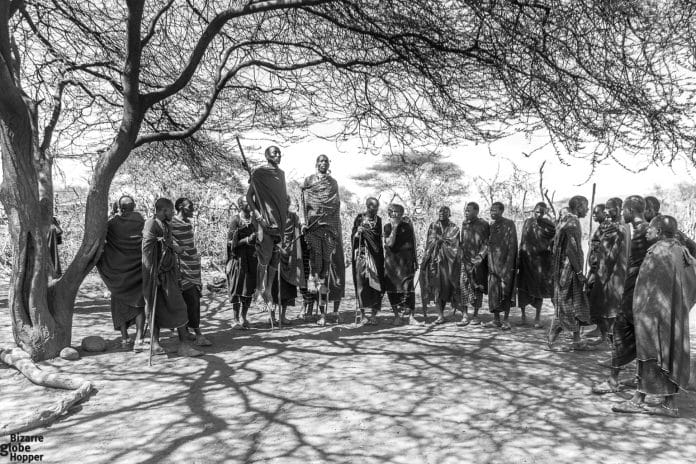Everything You Need to Know About Maasai People
Who are the Maasai People?
The Maasai people are Nilotic tribe members living in northern, central and southern Kenya and also found in the north side Tanzania. They are among the most famous people in the world because of their lifestyle and environment being around many of the wildlife parks of the Great Lakes of Africa, their distinct traditions, dress code and without forgetting Maasai people height is usually on the tall spectrum, widely noticed. The Maasai people speak Maa, one of the Nilotic languages that are closely related to the Dinka, Kalenjin and Nuer languages. With the exception of some older Maasai people living in rural areas, most Maasai speak languages that are official in Kenya and Tanzania, namely Swahili and English. The population of the Maasai people is said to be approximately 1,189,522 in Kenya based on the 2019 census, compared to 377,089 reported in the 1989 census.
The governments of Tanzania and Kenya have launched programs to motivate the Maasai to abandon their traditional nomadic style, but the Maasai people of Kenya and Tanzania practice have continued to retain their old traditions. Many Maasai tribes today throughout Tanzania and Kenya welcome visitors to their villages to see for themselves their culture, traditions, and lifestyle, for a fee.
History of the Maasai People
The Maasai people location and their livelihood is mostly surrounding the Great Lakes region of Africa, whereby they arrived to the area by crossing through South Sudan. Many Nilotic speakers in the area, including the Maasai, Turkana and Kalenjin, are pastoralists, and are notoriously well reputed as feared heroes and tactical cattle rustlers. The Maasai and other East African groups have adopted traditions and practices from neighboring groups that are Cushites in origin, that consist of affairs such as an established system of social organization, circumcision ceremonies, and vocabulary terms.
Origin, Movement and Absorption into Dominant Maasai People Culture
From their history that has been passed through orally, the Maasai people of Africa are coming from the north side of Lake Turkana’s (which is in the northwest side of Kenya) lower Nile basin and they migrated to the south as of the 15th centry, reaching a long stretch of land which is now called northern Kenya all the way to the present day central Tanzania between the 17th and late 18th centuries. Many tribes that had already settled in the area were forced to relocate by the Maasai, while others, especially the Southern Cushite groups, they were included in the Maasai community. The Kalenji Nilotic ancestors likewise took over the first population of the Cushite community.
Where Do Maasai People Live?
Settlements in East Africa
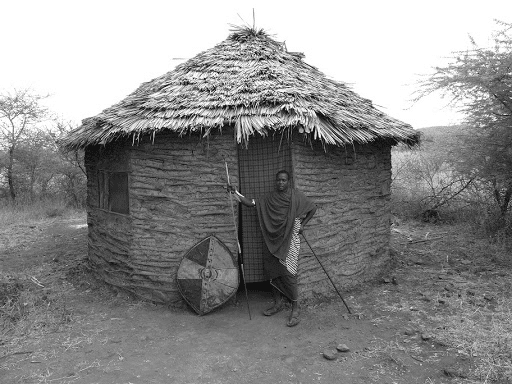
The Maasai empire grew up to its maximum in the middle of the 19th century, and occupied almost the entire East African Rift Valley and nearby lands from Mount Marsabit in the northern side to Dodoma in the south. At this time the Maasai people, together with a bigger Nilotic group played a big role of, grazing cattle all the way up east to the shores of Tanga in Tanganyika (which now mainland Tanzania). Raiders used spears and shields, but they were highly respected by their powerful skills of throwing clubs (known as “orinka”) that could be accurately shot from a distance of up to 70 feet (about 100 meters). In year 1852, it was reported that a population of about 800 Maasai warriors where on the move to the present day Kenya.
In 1857, after destroying the “Wakuafi Wilderness” in what is now called southeastern Kenya, Maasai warriors threatened Mombasa off the coast of Kenya.
Because of this movement, the Maasai are considered the southernmost Nilotic speakers. The period of growth of this community was led by the Maasai “Emutai” of 1883-1902. This period was marked by epidemics of infectious pneumonia in cattle, rinderpest, and smallpox. The first estimate given by a German lieutenant in what was called northwestern Tanganyika, was that 90% of the cattle and half of the wildlife were extinct due to rinderpest. The Germany doctors at time within Tanganyika described that “in every second” an African’s face was getting a scar because of smallpox.
This period also went together with drought. The rains completely stopped between years 1897 and 1898.
Austrian explorer Oscar Baumann went on an expedition through the Maasai land between years 1891 to 1893, and narrated the
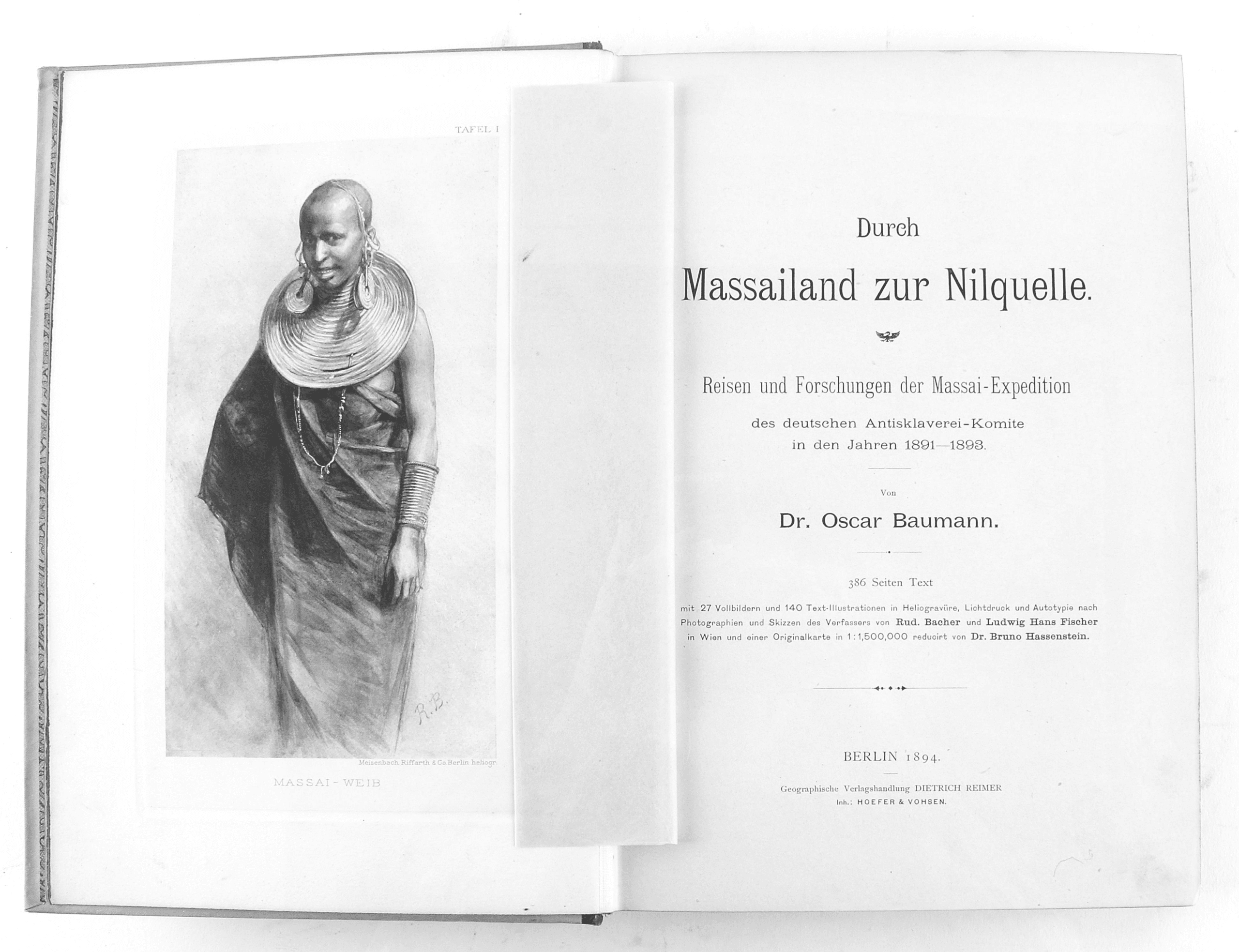
ancient Maasai settlement in the Ngorongoro Crater in the 1894 Durch Massailand zur Nilquelle book (“Through the Maasai land to the source of the Nile”): ” There were women rotten down to bones, from their eyes the madness of hunger was burning … the warriors could hardly crawl on all fours, and the desperate and tired elders. Groups of eagles followed them from above, waiting for some of their victims.” The approximate number of deaths during this episode was around two-thirds of all the Maasai people.
Beginning with the Treaty of 1904, followed by another in 1911, the Maasai territories in Kenya were reduced by 60 percent when the British removed them to make way for settler ranches, and later restricted them to what are now Samburu, Laikipia, Kajiado and Narok. The Maasai people in Tanganyika (now mainland Tanzania) relocated from the fertile soils between Mount Meru and Mount Kilimanjaro, and many parts of the fertile mountains close to Ngorongoro in the 1940s. More land was taken to create wildlife sanctuaries and reservesnamely: Samburu National Park, Ngorongoro Conservation Area, Lake Nakuru National Park and Tsavo in Kenya; Amboseli National Park, Nairobi National Park, and Lake Manyara, Maasai Mara people surroundings, Tarangire National Park and Serengeti National Park in what is now Tanzania.
The Maasai people are pastoralists in nature and have opposed the push of the Tanzanian and Kenyan governments to adopt more of a permanent lifestyle which do not moving around. They have been fighting for their human rights to graze for many national parks in both Kenya and Tanzania.
The Maasai people stood up against slavery and lived with many wild animals with a strong dislike of eating those wild animals or birds. The Maasai land currently has the best wildlife areas in East Africa. The Maasai community never allowed human trafficking, and therefore foreigners who were looking for people to serve them avoided the Maasai.
What Language Do the Maasai People Speak?
There are basically twenty-two geographical clans or sub-ethnic groups of the Maasai community, each with its own traditions, appearance, leadership and dialect. These divided groups are referred to as ‘iloshon’ or ‘nations’ in the language of Maasai people of East Africa known as Maa: Larusa, , Wuasinkishu, Kisonko, Laikipia, and Parakuyo, Matapato, Dalalekutuk, Kaputiei, Ilkirasha, Samburu, Loitokitoki, Keekonyokie, Salei, Sirinket, Lchamus, Damat, Purko, Moitanik, Loodokolani, Syria, Laitayiok, Loitai.
Genetics
Newly improvements in genetic analysis have allowed further insights to be found in relation to the origins of the Maasai people. The genetic genealogy, a instrument which utilizes genes of modern people to trace back their ethnic and geographical origins, has also paved a way in explaining the possible origins of the modern Maasai.
Autosomal DNA
The autosomal DNA of the Maasai people has been thoroughly investigated by Tishkoff and others (in 2009) on the genetic of various African populations. According to the authors of the study, the Maasai have “maintained their culture even through the aggressive challenges caused by extensive introgression of genetics”. Tishkoff et al. additionally explained that majority of Nilotic Cushites speaking groups like the Maasai, display numerous bits of assignments from the Nilo-Saharan […] and Cushitic […] AACs, in relation with evidences from use of language that is utilizing repeating Nilotic assimilation of Cushites over the past 3000 years and at a rapid pace of East African collective change linked to lactose tolerance.
Y-DNA
The Wood el (2005) Y chromosome study experimented numerous sub-Saharan Africa populations, including 26 Maasai men from Kenya, to check their paternal lineages. The authors discovered that haplogroup E1b1b-M35 (not M78) in 35% of Maasai people surveyed,. E1b1b-M35-M78 at 15 percent, their ancestor and the northernmost men of the Cushites, whose haplogroup was at the highest level lived at least 13,000 years ago. The second paternal lineage among the Maasai that showed up often was the Haplogroup A3b2, that is usually present in the Nilotic community, such as Alur; [was observed in 27% of Maasai men. The third DNA that appeared frequently in the Maasai community was E1b1a1-M2 (E-P1), which is usually present among people of sub-Saharan Africa; was found in 12 percent of sampled Maasai. Haplogroup B-M60 was also found in 8 percent of the Maasai surveyed, that is also existed in 30 percent (16/53) of the Nilotics of Southern Sudan.
Mitochondrial DNA
Basing on a research by mtDNA Castri and others. (2008), which tested the Maasai people in Kenya, the maternal lineage found among the Maasai is quite different, but it is generally similar to that seen by other Nilo-Hamitic people from the area, like the Samburu. Most of the Maasai tested had subspecies of macro-haplogroup L, consisted of L0, L2, L3, L4 and L5. The gene sequence of mothers from North and North East Africa was also reported, mainly through the existence of mtDNA haplogroup M lineages of approximately 12.5 percent of the sample Maasai.
What are the Maasai People Most Known For?
Culture
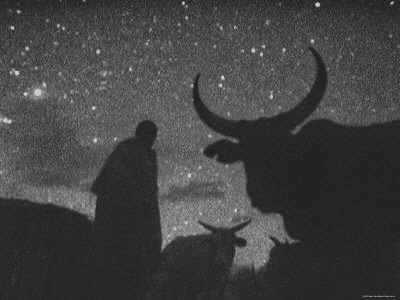
The Maasai community is largely patriarchal, with older men sometimes joined by retired traditional leaders, in making major decisions for each Maasai group. A complete oral law body covers many aspects of behavior among Maasai people. The official death penalty is unknown, but usually the cattle’s payment will end things. A process that does involve court is called amitu, which means ‘making peace’, or arop, which consist of apologizing profusely. The Maasai who are monotheistic do worship one God called Enkai or Engai. Engai has two natures: Engai Narok (black God) who is good, and Engai Na-nyokie (Red God) is vengeful. There are also two guardians or spirits of the Maasai community: Oodo Mongi, Red Cow and Orok Kiteng, Black Cow and sub-sections of five clans or offspring. The Maasai also have a ghost / image of an animal, which is a lion; however, the animal can be killed. The way the Maasai kill lions differs from hunting as they are used in rituals. The “Mountain of God”, Ol Doinyo Lengai, is located in northern Tanzania and can be seen from Lake Natron in southern Kenya. The central figure in the Maasai people religion and its whole system is rooted from the Laibon whose functions include healing, divination and prophecy, and ensuring success in war or rain. Today, they also play a political role due to the elevation of leaders. Any power that the Laibon had was the work of personality rather than title. Many Maasai people have nowdays also embraced Christianity and Islam. The Maasai are known for their high-quality ornaments and for decades, have sold these items to tourists as a business.
The high rate of infant mortality among the Maasai people has resulted in children not being properly identified until they reach the age of 3 months, stage known as ilapaitin. Education provided to the women of the Maasai community in using clinics and hospitals when pregnant has led to major improvement in infants survival rates.
Except in very remote areas the situation is different. For the Maasai living a traditional way of life, the end of life is never a festive, and the dead are in most cases left out to be eaten by wild animals. Corpses that are not consumed by scavengers do tend to be treated as problematic, and may cause embarrassment in society; therefore, it is not uncommon for bodies to be poured oil and blood from a slaughtered cow to make it appetizing for scavengers. Funerals have long been reserved for senior officials known as chiefs, as it is believed to be dangerous to the soil.
The traditional life of the Maasai people revolves around their cattle, which are their main source of food. Person wealth in the Maasai community is gauged basing on the number of cattle and children one has. A herd of 50 cows is respected, and more children is always considered better. A person who has more of one of these and not the other is considered poor. The Maasai religious belief explains that God gave all the cattle in the world, leading to the belief that raiding cattle from other tribes is just a matter of restoring what is their right, a practice that has become very rare.
So, what do Maasai people eat? All the Maasai people food requirements are fulfilled from their cattle. They eat meat, drink milk every day, and drink blood sometimes. Cattle,
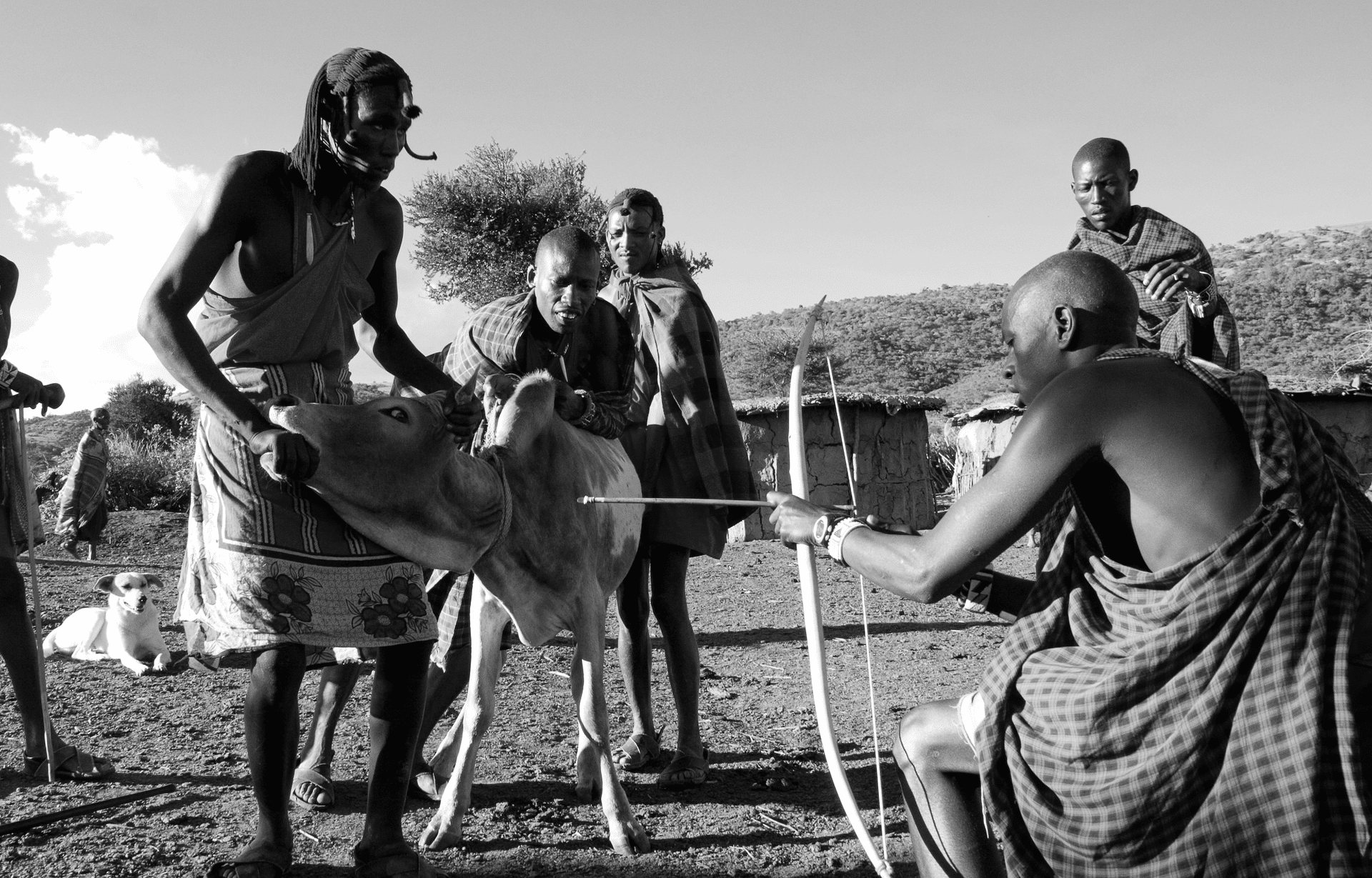
goats, and sheep are slaughtered for meat on special occasions and for ceremonies. Even though, basing on history the Maasai lifestyle has always been dependent on their cattle, but due to decline of their livestock population in recent years, the Maasai have learned to find alternative food including but not limited to potatoes, sorghum, rice and cabbage (known among Maasai people as leaves for goats).
Influence from Foreigners
The traditional pastoral lifestyle has become more difficult due to the external influences of the modern world, a situation which is among the many Maasai people facts associated with they way they live today. Garrett Hardin’s article, describing the “common catastrophe”, as well as Melville Herskovits’ “Cattle Controversy” helped to convince ecologists and policymakers about the effects that Maasai pastoralists were causing on the savannah plains. This concept was later proven to be false by anthropologists but is still deeply rooted in the minds of Tanzanian ecologists and officials. This persuaded British colonial policymakers in 1951 to evacuate all Maasai from the Serengeti National Park and relocate them to areas near the Ngorongoro Conservation Area (NCA). The NCA’s plan was to put the Maasai interests first, but this promise was never fulfilled. The spread of HIV was extreme.
Because of the increase in the Maasai population, the disappearance of cattle from diseases, and the lack of land on the plains due to new reserves’ boundaries and the entry of settlements and farms by other tribes (this is also the main reason for the decline in wildlife natural environment, followed by poaching), the Maasai people were forced to devise new means of subsistence. Many Maasai then began cultivating maize and other food crops for their livelihood, a practice that was viewed as culturally distorted. Agriculture was first introduced to the Maasai through relocated WaArusha and Meru women who were married to Maasai men; as a result generations after made a mixed type of lifestyle. To make matters worse, in 1975 the Ngorongoro Conservation Area banned agriculture. From this perspective, to survive Maasai people in Tanzania had to participate in the country’s normal financial economy. They now have to sell their animals and traditional medicine to buy food. The agricultural ban was lifted in 1992 and agriculture has again become an integral part of the Maasai life again. The boundaries of conservation and land privatization have continued to reduce the grazing area for the Maasai and have forced them to change drastically.
Over the years, many projects began to help Maasai tribal leaders find ways to preserve their traditions and to find a balance with the educational needs of their children in the modern world.
Emerging forms of employment among the Maasai include agriculture, trade (running restaurants / shops, selling traditional medicine, buying and selling minerals, embroidering, selling milk and dairy products to women), and wage employment (as security guards / watchment, tour guides, attendants), and others who are involved in the public and private sectors.
Many Maasai have left the nomadic life to go to positions in business and government. However, despite the modern urban lifestyle that they can go to, many will be happy to return home wearing creative clothes, they will just leave the traditional family Maasai people homes wearing sheets (colored fabric), cowhide leather shoes and carrying a club made of wood (o-rinka) – something that makes them comfortable with themselves.
Social Groups
A pillar in the Maasai community is a set of age system. Little boys are sent out with calves and sheep as soon as they can walk, but childhood for boys is a time to play, except for ritualistic beatings done to them to challenge their courage and endurance. Girls are responsible for tasks such as cooking and milking, skills that they learn from their mothers at a young age. Every 15 years or so, a new and self-aware generation of Morans or Il-murran (heroes) is formed. This includes most boys between ages of 12 and 25, who have reached puberty and are not part of the prior age group. One rite of passage from adolescence to the status of a young warrior is the 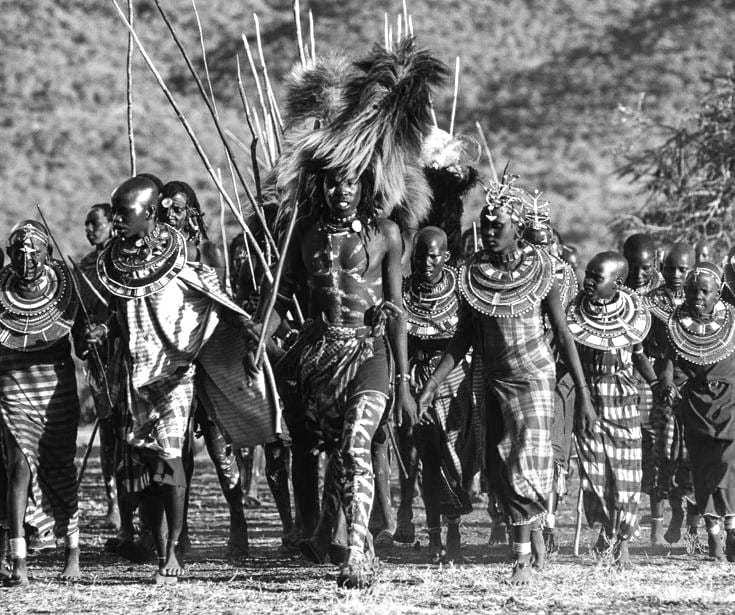 ritual of circumcision performed without anesthesia. In modern times, Maasai boys living nearby suburbs that have doctors are practicing the ceremony in a safer manner, but still with no anesthesia because they must endure the pain that will convert them to become men. These rituals are usually performed by the elders, who use a sharp knife and traditionally made bandages from cattle for the procedure. The word for circumcision in Maasai language is emorata. The boy must endure the operation in silence. Showing a state of pain brings shame, though it is temporary. Any state of shock can lead to accidents in a process that requires careful and tedious effort, which can lead to lifelong scars, dysfunction, and longterm pain. The process of getting healed is usually about 3 – 5 months, throughout this time the Maasai boy may be experiencing challenges with urination accompanied with pain, and for 4 – 8 months they are required to wear black Maasai people clothing.
ritual of circumcision performed without anesthesia. In modern times, Maasai boys living nearby suburbs that have doctors are practicing the ceremony in a safer manner, but still with no anesthesia because they must endure the pain that will convert them to become men. These rituals are usually performed by the elders, who use a sharp knife and traditionally made bandages from cattle for the procedure. The word for circumcision in Maasai language is emorata. The boy must endure the operation in silence. Showing a state of pain brings shame, though it is temporary. Any state of shock can lead to accidents in a process that requires careful and tedious effort, which can lead to lifelong scars, dysfunction, and longterm pain. The process of getting healed is usually about 3 – 5 months, throughout this time the Maasai boy may be experiencing challenges with urination accompanied with pain, and for 4 – 8 months they are required to wear black Maasai people clothing.
During this period, newly circumcised young men will live in the “manyatta”, “shelter” built by their mothers. Manyatta has no surrounding barriers for protection, this is done for emphasizing the warrior’s role in protecting society. No internal Kraal (barn) is built, as the warriors do not own cattle or work to know numbers of cows. More rituals are required before reaching the status of a senior warrior, whereby at the highest stage is the eunoto ceremony, “coming of age”.
When a new generation of heroes is formed, the existing Il-murran will graduate as the youngest elders, who the become responsible for political decisions until they become older. This graduation from hero to young man takes place at a large gathering known as Eunoto. The long hair of the old warriors is shaved; seniors must trim their hair short. Heroes are not allowed to have sex with circumcised women, although they may have female friends who are uncircumcised. In Eunoto, heroes who have successfully obeyed these laws are especially recognized.
The Maasai warriors spend most of their time now traveling in the Maasai lands, beyond their borders. They are also more involved in the cattle trade than ever before, promoting and improving numbers through trade and exchange rather than stealing as in the past.
One myth about the Maasai people is that every young man must kill a lion before being circumcised. Lion hunting was a long-standing practice, but it was banned in South East Africa – but lions are still hunted if they invade Maasai herds, and young warriors who participate in traditional lion killings do not face any consequences with the law. Raising concerns about the lion’s population has led to at least one program that promotes the morale of people to accept compensation when lions kill livestock, instead of hunting and killing the lion itself. However, killing a lion gives a person great pride and prestige in the community.
Young women are also circumcised (known as “female circumcision”, “female genital mutilation,” or “emorata”) as part of a careful right of passage known as “Emuatare,” a ceremony that introduces young Maasai girls to adulthood through traditional circumcision and then to marriages planned in advance. The Maasai people believe that female circumcision is necessary and that Maasai men may reject any woman who has not been circumcised as she is not marriage material or does not deserve a higher dowry price. In East Africa, uncircumcised women, even those with higher education MPs like Linah Kilimo, can be judged for not being mature enough to be paid attention to in various serious matters. For some, the practice of female circumcision is known as female genital mutilation (FGM), and it leads to widespread criticism from outsiders and many women who have gone through it, such as Maasai activist Agnes Pareyio. It has recently been changed in some cases to a “cutting with words” ceremony that includes singing and dancing instead of FGM. However, these practices are still highly regarded and valued by the culture. “Emorata” is a Maasai word which means circumcision and it is used to both male and female mutilation of genitals. Female circumcision is illegal in Kenya and Tanzania. These circumcisions are usually performed by an invited ‘specialist’ who is usually not a Maasai, usually from the Dorobo group. The sharp razors and knives that are utilized in cutting are designed and built by blacksmiths known as il-kuono, who are usually make weapons for the Maasai who do not have the knowledge to do so: (knives, spears and short swords known in Maa language as ol alem, simi or seme).
The same way, circumcised young Maasai females dress in black, decorate their faces with drawings, and when the ceremony is over they cover their faces.
Married women who become pregnant are allowed to abstain from heavy work such as milking and gathering wood. Sexual relationships are also banned and there are special rules that apply to pregnant women.
Maasai School in Tanzania
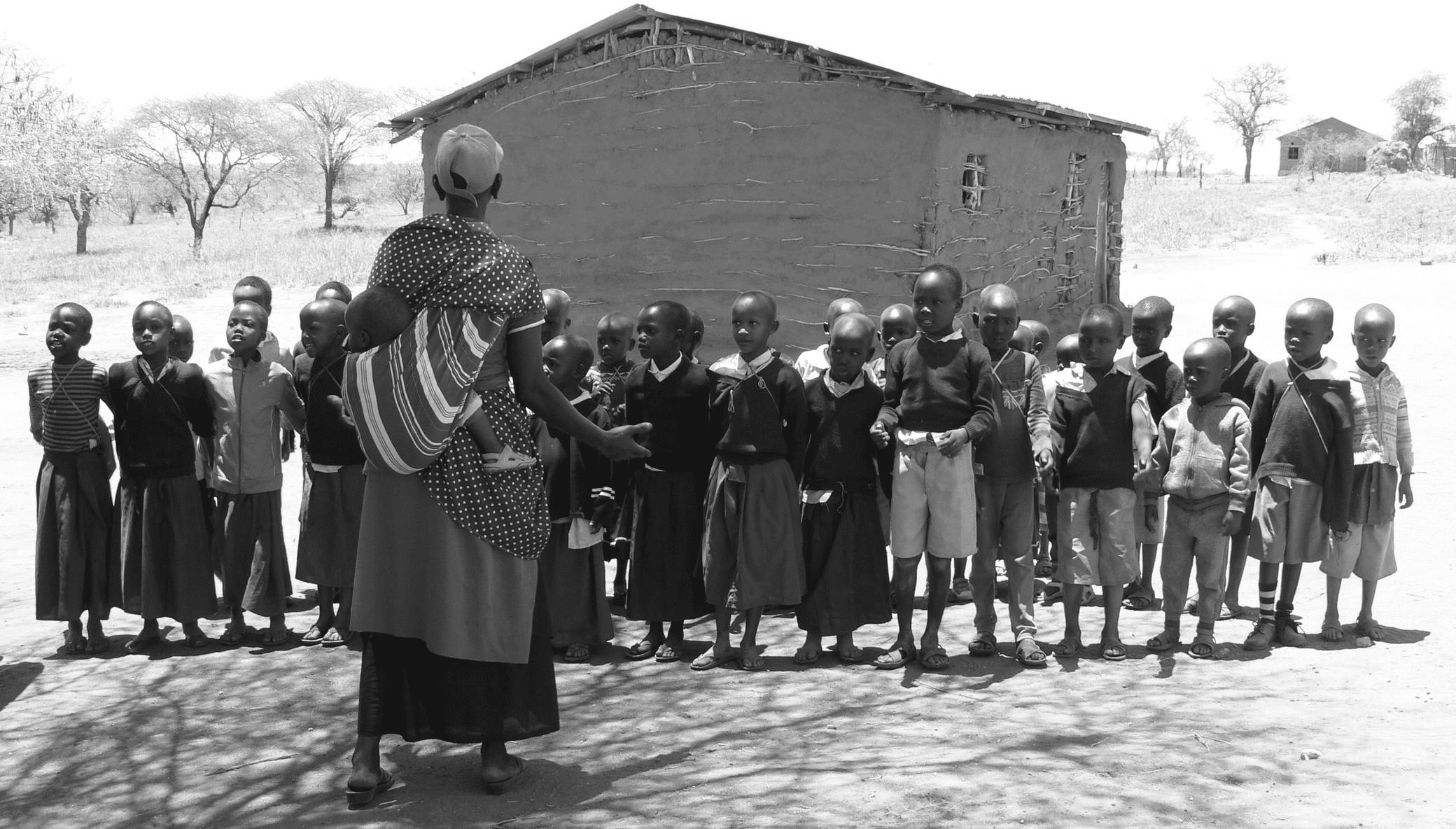
The Maasai people marriage is by nature involving many wives; this is considered to be a long-term and a best way to address the high mortality rates of infants and mothers. The system of a woman having many men also takes place. But, today this behavior has been abandoned. A woman is not only married to her husband but all her peers. Men are expected to leave their beds to a stranger of the same age; but, today this behavior has also been thronged out. The woman decides for herself whether to join the man who is visiting them. Any child who may be born as a result of a stranger’s encounter is the child of her husband and his offspring in the family line of Maasai communities. “Kitala”, a form of divorce or refuge, is possible in the house of the father in law, usually happens when there great abuse of the wife. Return of dowry, child care, and such are usually consented by proper agreements.
Music and Dance
Maasai music traditionally consists of rhythms performed by singers who sing in symmetry while the song leader, or olaranyani, sings the song. Olaranyani is usually the singer who can sing the song well, although several people can lead the song. Olaranyani begins by singing a line or title (number) of a song. The group will respond with one response of acceptance, and the partner will sing a verse on the group’s rhythmic singing that utilizes voices coming out of the throat. Each song has its own unique number structure based on call-and-answer. The most common sequence is in the change of time scores in the ratio of 5/4, 6/4 and 3/4. Songs follow a common theme and are often repeated words over time. The neck up and down movements is accompanied by singing. When breathing out the head is tilted forward. The head is turned backwards while inhaling. Generally the result is the release of many sounds that go together. Unlike many other African tribes, the Maasai people use a lot of rhythmic sounds.
Women sing the chorus, chanting hymns, and songs praising their young men. The form of call-and-answer, repetition of meaningless phrases, vocal chords, words repeated after each verse are sung in descending order, and singers responding to their verses are a characteristic of singing for women. Every time most Maasai women seat together, they usually perform dances together and singing.
One difference in the origin of the sound of Maasai people music is the use of the Great Kudu horn to call the moran at the Eunoto festival.
Singing and dancing are sometimes done around the house, and it involves flirting. Young males will form a line and sing in order, “Oooooh-yah”, with a snoring cough and growl as well as the thrusting and withdrawing of their lower bodies. The girls stand in front of the men and form a semi-circular pattern with the same pelvis movement while singing in a dry loud voice “Oiiiyo..yo” the opposite of the men. Although the bodies are close together, they do not touch each other.
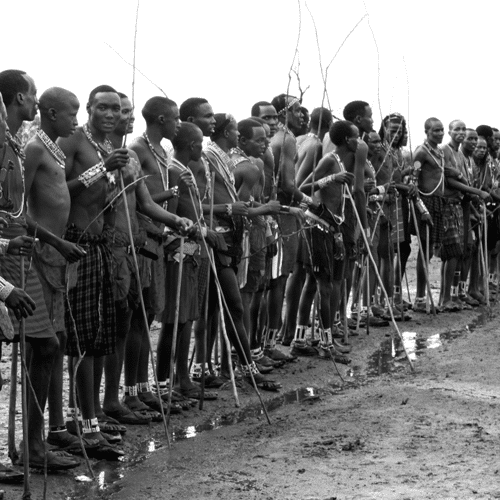
The celebration called “Eunoto” is an age set ceremony to welcome the coming of warriors, it follows with at least 10 days of dancing, worshipping and singing. Il-Oodokilani militants perform a form of march-past as well as the adumu, or aigus, sometimes known as “the jumping dance” by non-Maasai. (Both adumu and aigus are Maasai verbs meaning “jump” and adum means “Jump up and down during the dance”.) Fighters are known for this, and are often photographed during such competitive jumps. The circle is made up of heroes, and one or two at a time will step into the center to start jumping while maintaining a narrow posture, without allowing their heels to touch the ground. Group members can increase their singing depending on the length of the jump.
Moran female friends (intoyie) identify themselves with their lovely costumes as part of eunoto. Morani mothers sing and dance in honor of the bravery and courage of their sons.
Body Modification
Ear stretching and ear piercing are as common in Maasai as in other tribes. Various tools have been used to pierce and expand body parts, such as piercing thorns, twigs, bundles of branches, stones, parts of ivory and empty film cylinders. Few Maasai people, especially boys, follow this custom. Women wear a variety of ornaments made of beads in both ear lobes, and tiny piercings at the lower part of the ear. Among Maasai men, circumcision is performed as a rite of passage from adolescence to manhood. Women are also circumcised (as mentioned above).
Teen tooth extraction in childhood is a practice that has been reported in the Maasai of Kenya and Tanzania. There is widespread belief among the Maasai that diarrhea, vomiting, and other debilitating childhood diseases are caused by swelling of the gums over the canine region, which are thought to have ‘worms’ or ‘nylon’ teeth. These beliefs and practices are not unique to the Maasai people. In rural Kenya a group of 95 children between the ages of six months and two years were screened in 1991/92 and 87 percent were found to have had one or more canine tooth removed. In the younger age group (ages 3-7), 72% of the 111 children surveyed showed a loss of the upper or lower jaw teeth.
The Food of the Maasai Tribe People
Basing on their tradition. the Maasai people diet includes raw blood from cows, raw meat and raw milk. Remember that Maasai cattle are of the Zebu type. In the summer of 1935 Dr. Weston A. Price made a visit to numerous Maasai villages and concluded that basing on Dr. Anderson from a local government hospital in Kenya most tribes are free of disease. Most did not have a single tooth that was attacked by the presence of cavities or a single defective teeth. The Maasai, in particular, had a small 0.4 percent cavity in the teeth. He related these findings to Maasai people’s diet which includes (in terms of volume) raw milk, raw blood, raw meat and the amount of vegetables and fruits, although vegetables and fruits are not commonly part of the diet in most villages. He noted that whenever possible every baby growing and every pregnant or breastfeeding woman will be given a daily ration of raw blood. Dr. Weston A. Price also noted the government’s efforts back in 1935 to turn the Maasai into farmers. The ILCA study (Nestel in 1989) states: “Today, a strict Maasai diet consists of cow’s milk and cornmeal. Ugali which is a swahili term for a porridge that is in solid form, is consumed together with milk. Additionally ugali is not prepared with milk, the opposite situation with the normal liquid form porridge. Animal fat or butter is used for cooking, especially porridge, corn, and beans. Butter is an important food for infants.”
A study conducted by the African Veterinary Center (Kwakre et al. 1991) shows significant changes in the Maasai diet towards non-livestock whereby maize products amounted to about 12 to 39 percent sugar and 8-13 percent; about a liter of milk is consumed per person daily. Most milk is used as yoghurt or butter (used to make butter). Milk consumption statistics are very high by all standards. The protein and essential amino acid requirements are met and remain consistent. But, the availability of iron, niacin, vitamin C, vitamin A, thiamine and carbohydrates are never fully sufficient with dairy nutrition alone. Because of climate change, especially during the seasonal nature of milk supply and frequent droughts, many pastoralists, including the Maasai, now incorporate a large quantity of cereals in their diet.
The Maasai herd goats and sheep, including the Maasai Red sheep, as well as the most valued cattle. An electrocardiogram study on 400 young Maasai males found no evidence of heart disease, malnutrition or any dysfunction. Further carbon-14 studies showed that the average cholesterol level was around 50 percent of the average American. These results have confirmed the amazing quality of moran, which is “Olympic standard”.
Soups are probably the most important sources of herbal consumption in food for the Maasai people. Acacia nilotica is a frequently used soup plant. The roots or scales of the stem are boiled in water and the broth is used alone or added to the broth. The Maasai love to use this as a medicine, and it is known to make them strong, violent and fearless. The Maasai drink soup mixed with bitter tree barks and roots containing saponins which lower cholestoral; those urban Maasai who cannot find bitter herbs usually end up suffering from heart disease. Although used as a snack, the fruit is a major part of the diet of children and women who care after cattle and moran in the wild.
A mixture of cow’s blood, obtained by piercing a jugular vein of a cow, and milk is made to prepare a traditional drink for special ceremonies and as a nutrition for patients. However, blood incorporation in traditional diets is declining because of dropping of livestock populations. The Maasai people in recent years have learned to depend on alternative foods that are produced from other regions including but not limited to cabbage (known to the Maasai as goat leaves), maize flour, potatoes, rice and more.
The Maasai who live near crop farmers have engaged in agriculture as their main means of subsistence. In these areas, the size of the plots is generally not large enough to carry livestock; so the Maasai are forced to cultivate.
Settlements
As historic nomadic peoples and then relatively nomadic, the Maasai have traditionally relied on local materials, readily available and natural technology to build their homes. The traditional Maasai house was originally designed for people who move place to place and was therefore not always permanent. The houses are rectangular or oval, and are built by capable women. The structural system is made of wooden poles directly embedded in the ground and attached to small tree branches to form a fence, which is layered up with a combined mix of ash, mud, human urine, sticks, cow dung and grass. Cow dung ensures that the roof does not leak water. Enkaj or engaji is small, measuring 3 × 5 meters and stands at only 1.5 meters high. In this space, families cook, eat, sleep, share, and store food, fuel, and other household items. Small animals are also kept inside the enclosure. The villages are enclosed by a circular fence (enkang) built by men, usually using the natural thorn acacia tree. At night, all cattle, goats, and sheep are kept inside the center, protected from wildlife.
What Do Maasai People Wear?
Maasai people clothing changes according to age and location. Young Maasai people, for example, wear black clothes for several months following
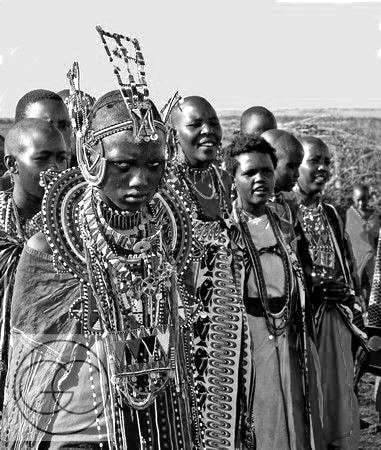
their circumcision. But, red is the preferred color. Blue, black, striped, and multi-colored fabrics are also worn, as well as African-colored designs. The Maasai began to replace animal skin, calf and sheepskin, and commercial cotton clothing back in the 1960’s.
Shúkà is a Maa word for sheets that are usually worn on the body. These are usually red, although they have other colors (such as blue) and bombwe (e.g. multi-colored sheets). The color of roses, even of flowers, is not worn by heroes. One piece of cloth known as a kanga, a Swahili word, is common. The Maasai near the coast can wear kikoi, a type of skirt that has many colors and different appearance. But, the preferred style is with striped lines.
Many Maasai people in Tanzania wear simple shoes, which until recently were made of cowhide. They are now attached to pieces of tire or plastic. Men and women wear wooden bracelets. Maasai women regularly weave ornaments to make necklaces. This work of beads plays an important role in the decoration of their bodies. Although there are differences in the meaning of the color of beads, some of usual meanings of a few colors are: white is for peacefulness; blue is for water; red is for fighter / blood / heroism.
The art of beadwork, practiced by women, has a long history among the Maasai people, who define their identity and place in society through body decoration and body painting. Prior to contact with Europeans, the beads were mostly produced from local raw materials. White beads were made of shells, clay, bones or ivory. Black and blue beads were made of metal, charcoal, seeds, clay, or ivory. Red beads came from seeds, wood, pumpkins, bone, ivory, red or white copper. During the late nineteenth century, a large number of red glass beads arrived in South eastern Africa, bead workers in the Maasai community replaced old beads with new materials and began to use more beautiful Maasai people colors. Currently, brightly colored glass beads with no decoration on the surface and soft natural finishing are preferred.
Hair
Shaving the head is common in many passage rituals, representing a new beginning that will take place when a person passes from one chapter to another for life. Fighters are the only people in the Maasai community who keep their hair long, which they weave in thin threads.
After reaching the age of 3 months, the baby is named and the head is shaved clean from the hair follicles, which resemble a bun, from the ends of the neck to the forehead. The cockade represents the “state of grace” given to infants. A woman who has suffered a miscarriage in a previous pregnancy puts hair on the front or back of the head, depending on whether she has lost a boy or a girl. This signifies the healing of the woman.
The heads of the Maasai boys are trimmed completely, two days prior their circumcision. Young heroes also allow their hair to grow back, and they spend a lot of time styling their hair. The hair is smeared with animal fat and waxed, and spreads over the head to the level of the ear. Hair is braided: it is divided into small parts that are divided into two sections and rolled, first individually and then together. Threads made of cotton or wool are used for straightening and elongate hair. The hair that is plaited can stay loose or tied together and clamped with leather. At the time warriors participate in the Eunoto ceremony, and transition to elders, their plaited hair that is long gets shaved. The to be brides just like their men gets the hair on their heads completely shaved as a symbolization of moving from one stage of life to the other and in the honor of the occasion.
Famous Maasai People
• Joseph Ole Lenku – Secretary of the Kenya Cabinet of Home Affairs and National Government Coordination from 2012 to 2014
• David Rudisha – Middle distance runner and world record holder 800 meters
• Edward Sokoine – Between years 1977 – 1980 and also 1983 – 1984, he was Tanzania’s Prime Minister
• Edward Lowassa – Between 2005 – 2008, he was Tanzania’s Prime Minister. The second runner up to John Pombe Magufuli in the 2015 Tanzania General Elections.
• Olekina Ledama – Founder, Maasai Education Discovery
• James Ole Kiyiapi – associate professor at Moi University and permanent secretary in Ministries of Education and Local Government
• William Ole Ntimama – a Kenyan politician and Maa community leader
• Francis Ole Kaparo – Kenya’s National Assembly previous Speaker
• Joseph Nkaissery – Former Secretary of the Kenyan Cabinet of Home Affairs and National Government Coordination from 2014 to his death in 2017
• Nice Nailantei Lengete – The first woman to address a council of Maasai elders on Mount Kilimanjaro, who pushed the council to ban female genital mutilation among Maasai people across Kenya and Tanzania
• Katoo Ole Metito – Member of Kajiado South County (sub-county).
For more articles on the Tanzania Tribes click here!

























